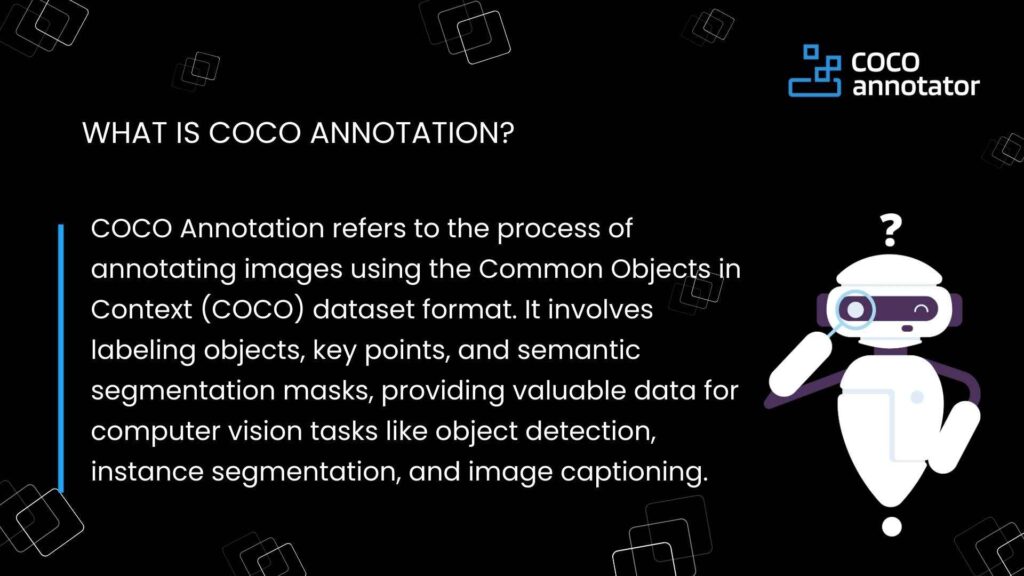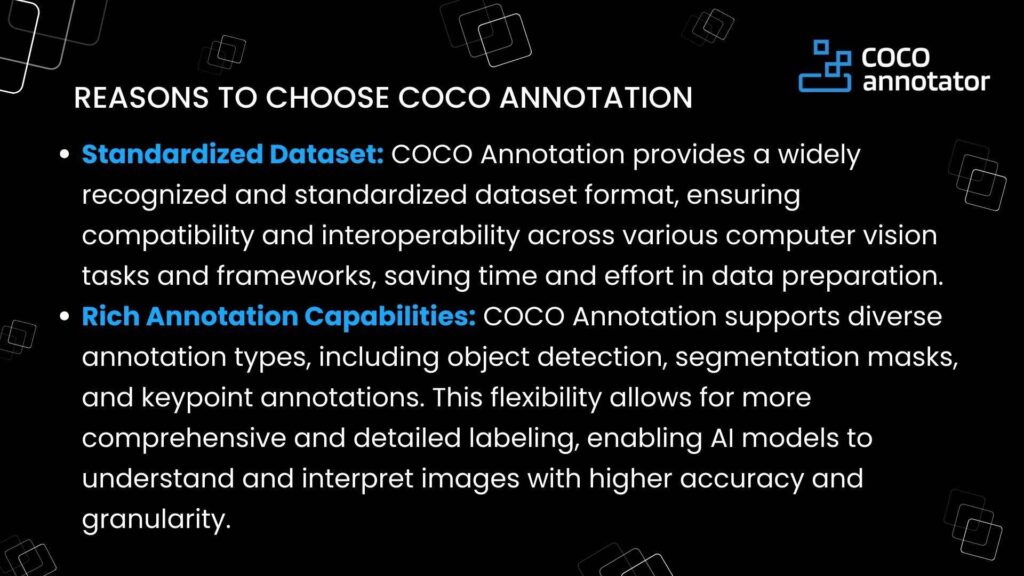
In the realm of artificial intelligence (AI) and computer vision, object detection plays a crucial role in understanding and interpreting visual content. To achieve accurate and robust object detection, choosing the right annotation format is paramount. The COCO annotation format has emerged as a leading choice for AI projects, offering a myriad of advantages, particularly, COCO object detection annotation plays a crucial role in creating high-quality training datasets for a variety of computer vision applications.
By leveraging the precision, richness, and efficiency provided by COCO annotation, AI models can achieve superior performance and a deeper understanding of image content. In this article, we will explore the top reasons why choosing COCO annotation is a wise decision for enhancing object detection capabilities in your AI projects.
Leveraging COCO Annotation for Superior Object Detection in AI Applications
COCO Annotation, short for Common Objects in Context Annotation, is a standardized and widely used annotation format in the field of computer vision; it’s a key player in the world of data annotation, offering several advantages for those looking to train machine learning and deep learning models. It provides a structured framework for labeling and annotating object instances in images, with the aim of enabling accurate object detection, segmentation, and other related tasks. The COCO annotation format is based on JSON (JavaScript Object Notation) and consists of two main components: image-level metadata and instance-level annotations.

In COCO Annotation, image-level metadata includes information such as image ID, file name, dimensions, and licensing details. The instance-level annotations encompass object-specific information such as bounding boxes, segmentation masks, class labels, keypoints, and captions. This detailed annotation format allows for precise and comprehensive labeling of objects in images, enabling AI models to better understand and interpret the visual content. COCO Annotation has gained popularity due to its versatility, flexibility, and the availability of large-scale COCO datasets, making it a valuable resource for training and evaluating computer vision algorithms across various domains.
The power of COCO lies in its detailed and versatile COCO annotation format, making it a highly effective tool for a range of computer vision tasks. Let’s delve into the reasons why COCO stands out in the world of image annotation:
Detailed Annotations
Unlike many other datasets that simply provide bounding box labels around an object, COCO goes a step further. It offers detailed segmentation masks for each object in an image, regardless of whether the objects are of the same type. This approach, known as instance segmentation, helps differentiate individual instances of an object, leading to a deeper understanding of the content in images. This nuanced information can significantly improve the performance of object detection models, allowing them to operate with higher accuracy and precision.
Rich and Diverse Dataset
COCO comprises a rich dataset with over 200,000 labeled images, covering 80 object categories. Each image is annotated with multiple types of annotations including bounding boxes, segmentation masks, and keypoints, providing a multifaceted perspective of the object in context. This diversity and richness make the object detection COCO dataset an excellent resource for training robust AI models, capable of handling a variety of computer vision tasks with high accuracy.
Versatility
COCO isn’t limited to object detection labeling. The COCO annotation format supports a wide range of computer vision tasks, making it a versatile tool for AI developers. These tasks include:
- Semantic Segmentation: This task involves categorizing each pixel in an image as belonging to a particular class or category, helping the model understand the context of the entire image.
- Keypoint Detection: For applications that involve recognizing or tracking human figures, COCO provides keypoints annotation that labels crucial points on a person’s body, such as elbows, knees, eyes, etc.
- Image Captioning: COCO also includes five different captions for each image, making it a valuable resource for training models in natural language processing tasks, such as image captioning or visual question answering.
This versatility ensures that the COCO dataset can serve as a comprehensive resource for training a variety of AI models, making it an invaluable tool in the world of computer vision.

By leveraging a data annotation company that specializes in COCO annotations, you can make the most of these advantages, ultimately leading to more reliable, high-performing AI models. The accurate and detailed annotations that COCO provides not only improve the effectiveness of your AI models but also provide a broader and deeper understanding of visual data, enabling more informed decision-making and smarter business solutions.
Top Reasons to Choose COCO Annotation
Choosing COCO Annotation for your AI projects offers an array of advantages, particularly when it comes to object detection computer vision tasks. Here are the top reasons to make this choice:
- Superior Precision with Image Object Detection: COCO provides a comprehensive dataset with precise labels and annotations, leading to more accurate image object detection. This improves your AI model’s understanding and interpretation of image content.
- Boost AI Object Detection Capabilities: The richness and diversity of the COCO dataset significantly enhance the performance of AI object detection. This ensures your AI model can recognize and distinguish between various objects within an image, contributing to a more effective and efficient AI system.
- Custom Object Detection: With its highly detailed annotations, COCO supports the development of custom object detection models. These models can be tailored to meet specific project or industry requirements, adding versatility and adaptability to your AI project.
- Deep Learning Object Detection: The vast and diverse data provided by COCO make it a valuable tool for training deep learning models for object detection. Deep learning models can learn complex patterns and make accurate predictions based on the intricate annotations in the COCO dataset.
- Keypoint Object Detection: COCO is not just about object detection and COCO segmentation; it also includes keypoint annotations for a select set of object categories. This provides additional information about the objects, such as the orientation or pose, adding another layer of complexity and accuracy to your AI models.
- Efficient Labeling of Images for Object Detection: The structured and comprehensive annotation format of COCO simplifies label images for object detection. This reduces the time and resources required for annotation, leading to increased productivity and cost savings.
Choosing COCO for your data annotation needs thus equips your AI models with a robust and detailed understanding of image content. This can significantly improve your model’s object detection capabilities, driving superior performance in your AI applications.

The Benefits of Accurate Object Detection
Accurate object detection is critical in the realm of computer vision and machine learning. It refers to the ability of AI models to identify, classify, and locate different objects within an image or video frame accurately. The ability to accurately detect objects can dramatically enhance the capabilities of various AI applications, providing numerous benefits, which include:
- Improved AI Model Performance: The accuracy of an AI model hinges significantly on the quality of the training data. When data is annotated correctly with precise object detection, AI models can interpret visual data more accurately, leading to improved overall performance. This results in higher precision, better recall rates, and lower false-positive rates in tasks such as image classification, object detection, and segmentation.
- Enhanced User Experience: In consumer-facing applications like augmented reality, social media filters, or e-commerce applications, accurate object detection can dramatically enhance the user experience. For example, in a virtual try-on feature of an online shopping platform, accurate object detection ensures that the virtual items fit perfectly on the user’s image, delivering a seamless and engaging user experience.
- More Informed Decision Making: Accurate object detection allows businesses to extract granular, nuanced insights from visual data. For example, in retail, accurately detected objects in CCTV footage can provide insights about customer behavior patterns, product popularity, and store layout effectiveness, leading to more informed business decisions.
- Increased Safety and Security: In areas like surveillance and autonomous driving, the importance of accurate object detection cannot be overstated. Detecting objects accurately in real-time can help prevent accidents, identify suspicious activities, and enhance overall safety and security.
- Customizable Solutions: Accurate object detection enables businesses to develop customized AI solutions tailored to their specific needs. For example, a healthcare company can develop an AI model to detect specific diseases in medical imaging, while an agriculture company may use object detection to identify pests or diseases in crops.
- Automation and Efficiency: By automating the process of identifying and classifying objects in images or video, businesses can achieve significant efficiencies. This can be particularly valuable in industries such as manufacturing and logistics, where object detection can be used for tasks ranging from quality control to inventory management, resulting in substantial time and cost savings.
Conclusion
The COCO dataset for object detection offers a valuable tool for creating robust and efficient AI models. With its detailed annotations and versatility, COCO is an excellent choice for object detection, segmentation, and other computer vision tasks.
Whether you’re working on image segmentation COCO object detection, deep learning object detection, or custom object detection, the detailed and precise labels provided by COCO can significantly enhance the performance of your AI model.

